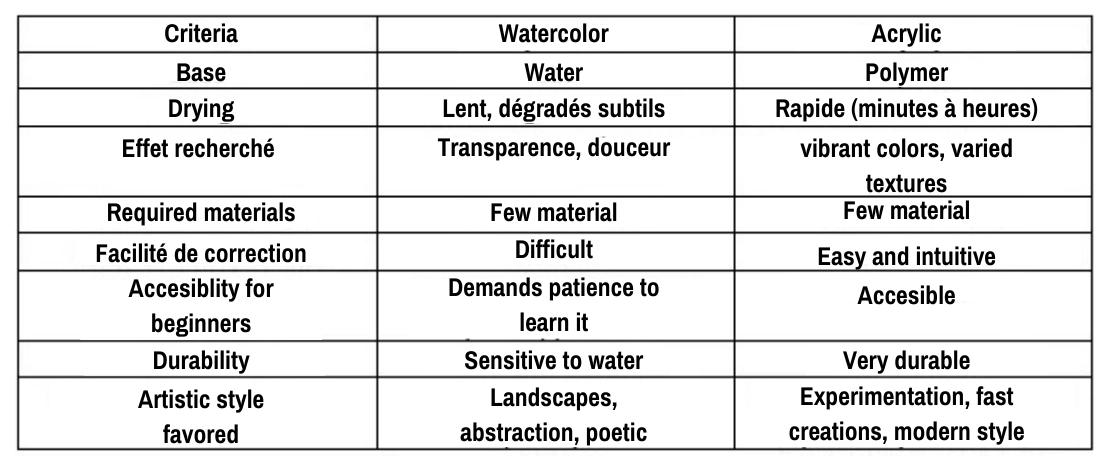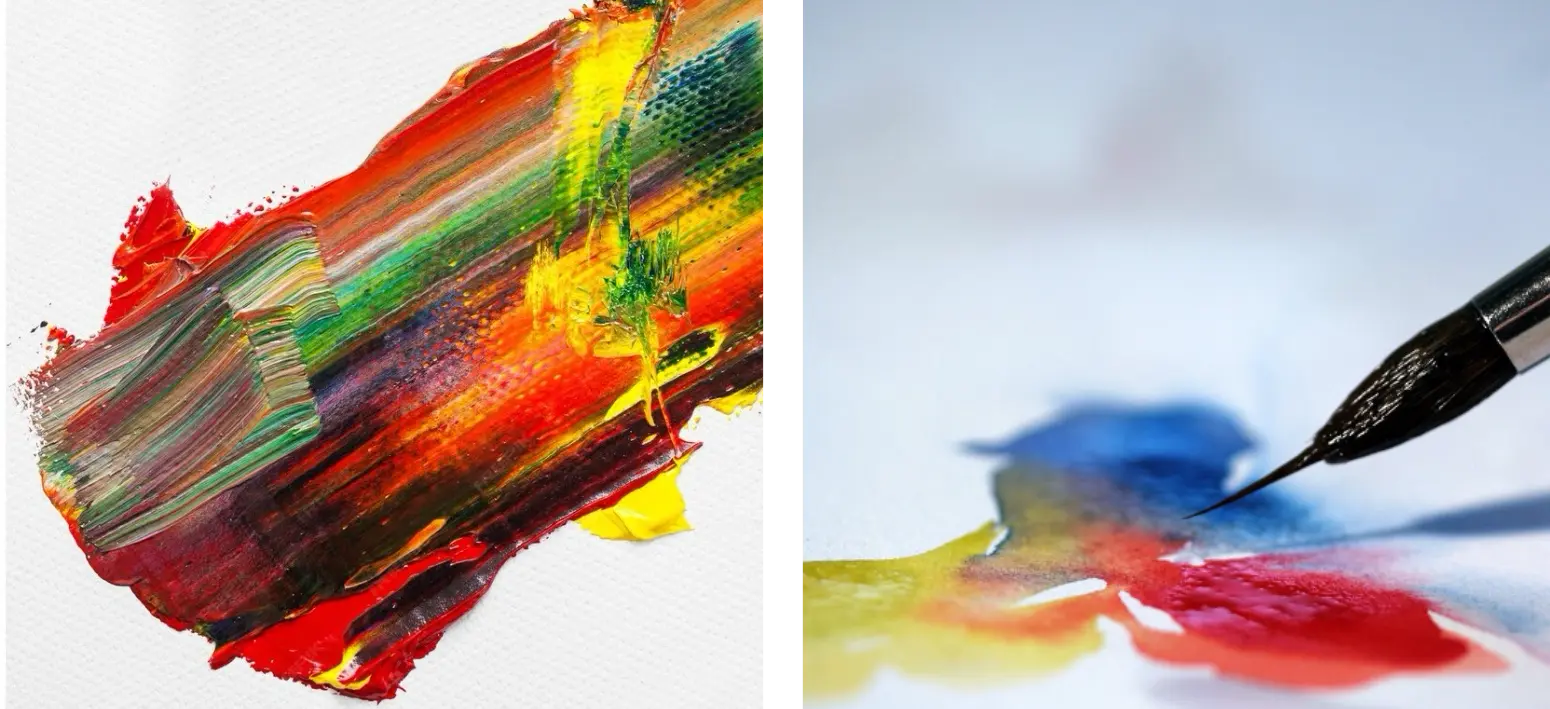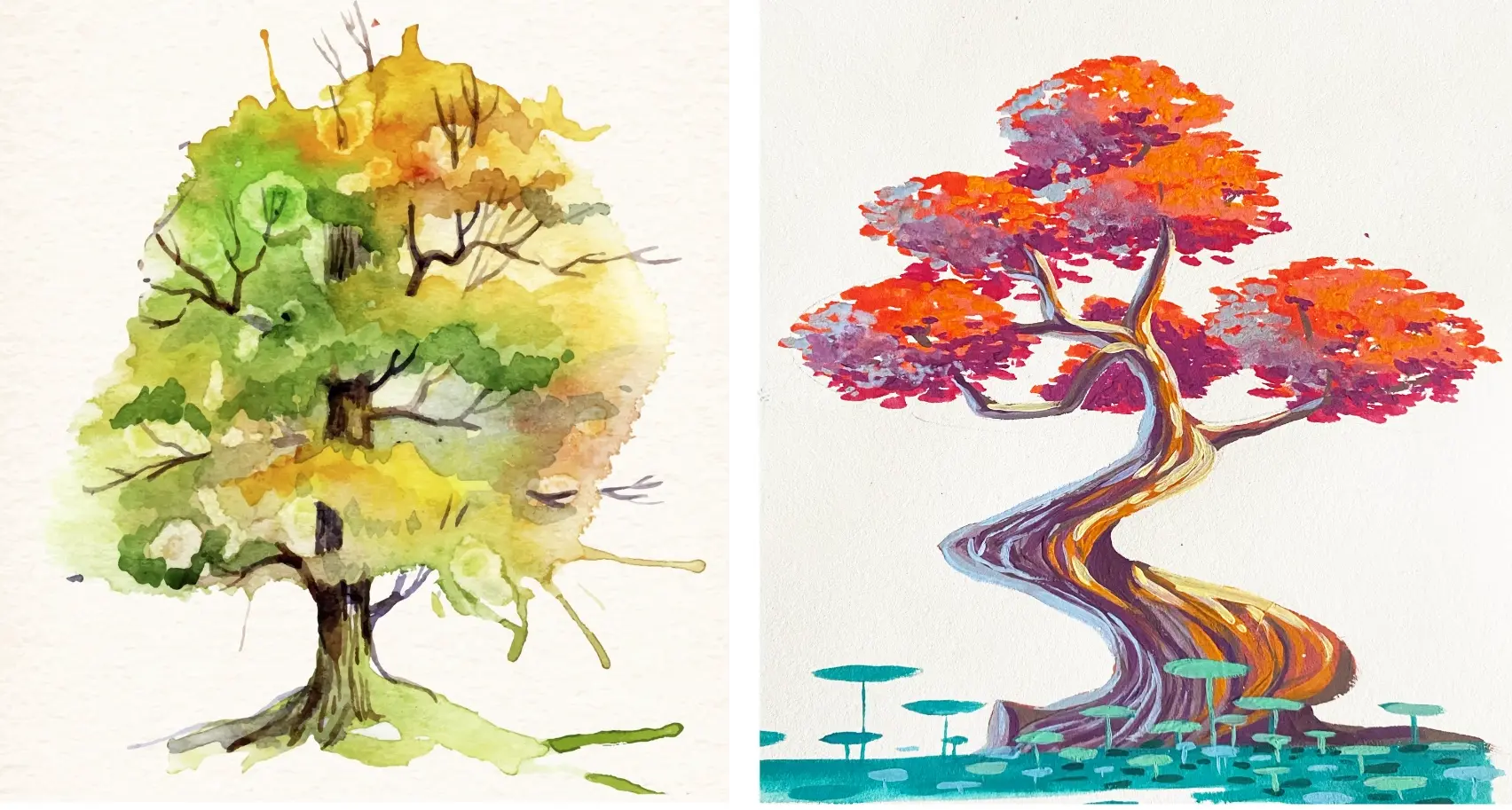Acrylic Painting Vs Watercolor

Hello everyone! Are you interested in getting into painting, but are unsure whether to choose watercolor or acrylic? Or perhaps you've already tried one and are wondering if the other technique might be better suited for you? Don't worry, you're in the right place! In this article, we will review the characteristics of each to help you choose the one that best fits your artistic desires.
Knowing the basics
In this article, we will compare these two exciting techniques. Please note: for a fair comparison, I will assume that both the watercolor and acrylic used are of good quality. If you are a beginner, I advise that you avoid using equipment that is of too poor a quality in order to fully enjoy everything each technique has to offer! I will also not delve into technical details on how to use these techniques or choose your equipment. If you are interested, I refer you to these articles:
How to Start with Watercolor Painting
How to Get Started with Acrylics
How to Choose Your Watercolor Paper
Let's compare the features of these two techniques
Opacity
Opacity is one of the aspects where watercolor and acrylic show great differences. Watercolor is essentially transparent paint: it uses the light of the paper and the play of layering to create effects of depth and subtlety. Each layer remains visible through the next, which requires working with lightness and anticipating your movements.
On the other hand, acrylic is generally a covering paint: it allows you to easily cover a previous layer, add corrections, or apply dense flat tints. However, be careful, not all acrylic colors are perfectly opaque. Some shades, especially yellows, reds, and very light colors, may remain slightly transparent and require multiple layers for a completely uniform appearance.

Watercolor Acrylic
Texture
The texture of watercolor and acrylic is also very different and greatly influences how you paint. Watercolor is a fluid, light, almost elusive paint. When mixed with water, it moves freely on the paper, creating soft gradients, unpredictable blends, and delicate transparency effects. It does not form a relief: everything is determined in the finesse of the layers and in the management of the water.
Acrylic, on the other hand, has a denser and creamier texture. Depending on its dilution, it can be worked in a very fluid manner, similar to gouache, or remain thick to add volume and texture effects. Some mediums can even enhance this textured aspect, allowing for the creation of impasto and relief directly on the canvas.

Watercolor Acrylic
Blending colors
Blending colors works quite differently between watercolor and acrylic. With watercolor, it is possible to directly mix the pigments on the palette to obtain new shades, but also, and this is where its subtlety lies, by layering multiple transparent layers on the paper.
Each layer then acts as an additional veil of color, somewhat like placing colored filters on top of each other. This enables the creation of rich, bright, and sometimes unexpected nuances. You can also work on a very wet sheet and let the colors naturally blend into each other.
Acrylic, on the other hand, favors mixing on the palette before application. Once applied, the paint dries quickly and becomes more difficult to rework wet into wet. However, thanks to its covering power, it is easy to add new colors on top, correcting or enhancing hues as layers accumulate. The blending process is therefore more direct with acrylic, while it remains much more organic with watercolor.

Acrylic Watercolor
Process
The method of working with watercolor and acrylic is not the same, as each technique imposes its own pace and habits. In watercolor, you generally work from light to dark.
The natural transparency of the paint requires preserving the light areas from the start, as it is difficult, if not impossible, to go back and recover them later. Everything is built up gradually, in light layers, controlling the moisture of the brush and the paper to achieve the desired effect.
Conversely, acrylic offers a more flexible approach: you can start with dark flat areas and lighten them later, or rework an area that has already been painted without any problems. The quick drying time requires working in stages, thinking of the painting as a construction, layer by layer, but also allows more room for correction and adjustments.

Rendering
The overall rendering of watercolor and acrylic offers very different atmospheres. Watercolor provides an airy, bright, often delicate result. The colors appear vibrant yet light, due to the transparency of the paint and the texture of the paper that remains visible.
With watercolor, you can also achieve a form of randomness, especially when mixing each shade with others, which brings a quite lively aspect to the overall rendering.
On the other hand, acrylic provides a denser and more pronounced finish. The colors are more vivid, more brilliant, with the ability to play on strong contrasts and texture. Depending on how it is used, acrylic can remain smooth and clean or, conversely, become very textured, almost sculptural. Note that you can generally clearly see the brush strokes or marks from other tools used.

Watercolor Acrylic
Cost
In terms of cost, when compared at similar levels, both are equal. Indeed, neither requires a lot of equipment, and it generally boils down to paper, brushes, and paint.
In general, acrylic is much cheaper than watercolor. However, due to its high dilution with water, watercolor is used much more slowly and, therefore, over the long term, this balances out. However, note that if you want to invest in very high-end products, watercolor can become more expensive.

Comparative chart of watercolor and acrylic
Here is a comparison table of the two so you can see a good summary of what we just discussed:

Which technique should you choose: watercolor or acrylic?
So, which technique should you choose? If you haven't made your choice yet, here are some main points to consider to guide you:
Your budget:
Small budget? ➔ Acrylic (cheaper, easy to find).
Larger budget? ➔ Watercolor (can become more expensive with high-end materials).
Your work comfort:
Do you like to work fast, without waiting? ➔ Acrylic (dries quickly, ideal for spontaneous work).
Do you prefer to take your time and explore nuances? ➔ Watercolor (slower, but ideal for gradients and subtlety).
Your project:
A fast, dynamic project? ➔ Acrylic (quick to work with, perfect for various formats).
A long-term piece, with many details? ➔ Watercolor (ideal for delicate and meticulous works).
Your work approach:
Do you like to experiment or create thick textures? ➔ Acrylic (very versatile, ideal for bold effects).
Looking for bright and transparent colors? ➔ Watercolor (perfect for gradients and lighting effects).
The format of your work:
Large formats or long works? ➔ Acrylic (well-suited for large formats, and dries quickly between layers).
Small formats or more detailed works? ➔ Watercolor (perfect for small compositions and fine details).
In summary, the choice between watercolor and acrylic depends on your working style and priorities. Watercolor is ideal for subtle gradients, light textures, and projects where patience and precision are essential.
Acrylic, on the other hand, is distinguished by its speed, versatility, and accessibility. Each technique has its advantages, so it's up to you to choose the one that suits your style, pace, and projects!
I hope this article has helped you to understand things more clearly. 😊
Editor and illustrator: Chloé Pouteau

